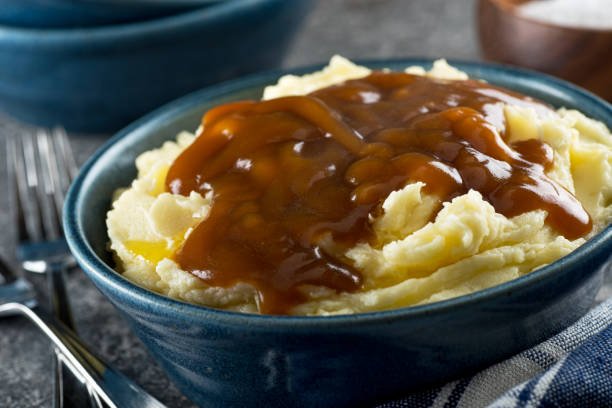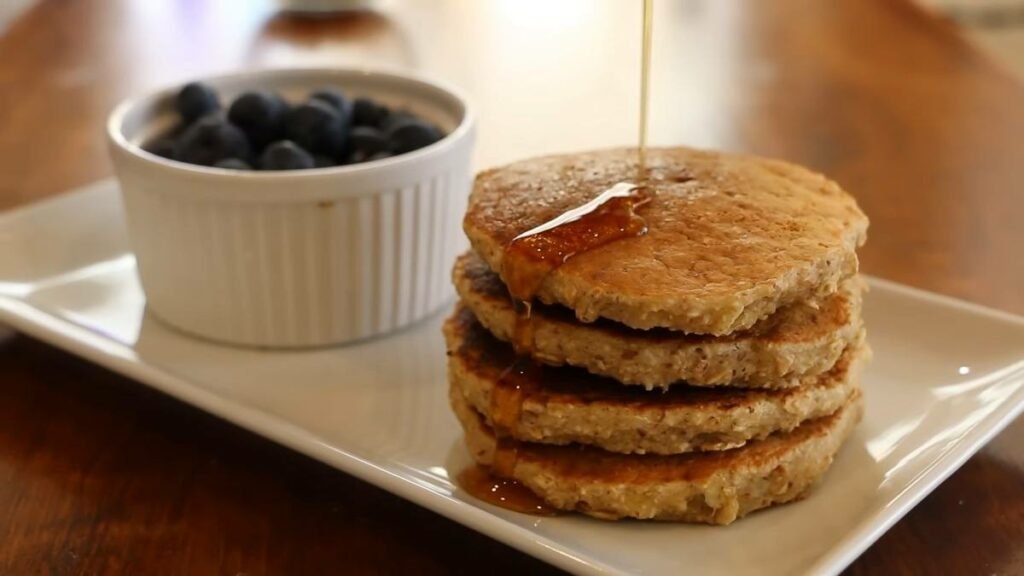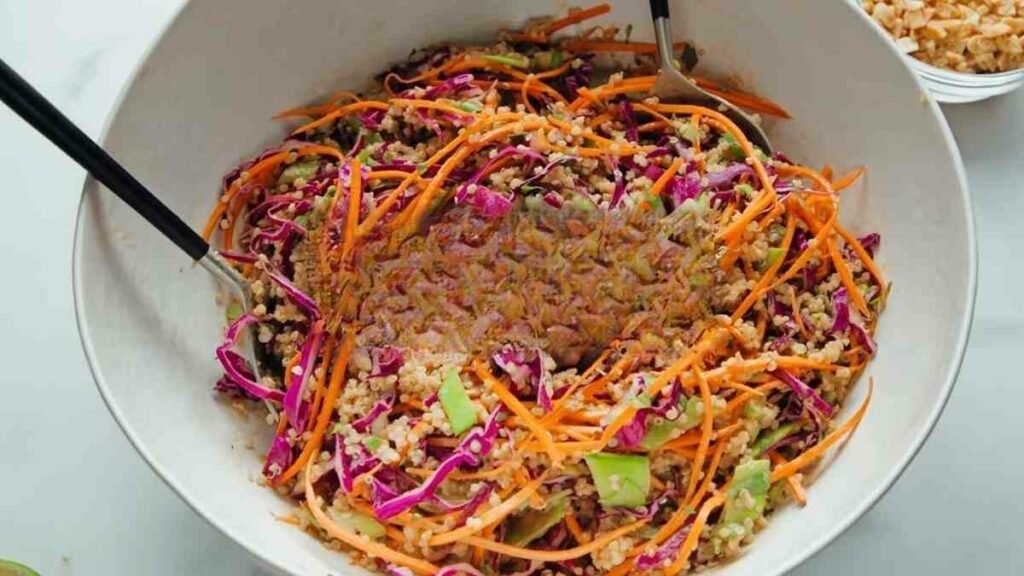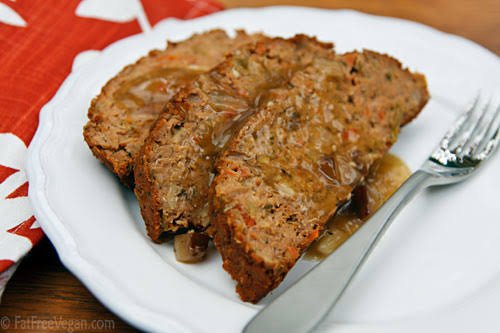Salad has always been a go-to choice for light and nutritious meals. However, most salad dressings rely on oil as a key component. This has been a big problem for people with dietary needs, as oil often adds unnecessary calories and fats to the meal. The oil-free salad dressing is a healthy alternative to traditional salad dressing. This alternative gives you all the nutrition you need without compromising on taste.
One of the things that sets this recipe apart is its unique taste. Without the inclusion or heaviness of oil, you can taste the vibrant flavors of fresh herbs, citrus, and other ingredients used in pressing the salad. The oil-free salad is versatile and can be used as a dressing or dip for raw vegetables.
Ingredients/equipment for Oil-free Salad Dressing
There are several ingredients you need to prepare this recipe. Here is a list of the ingredients below.
- 1 ripe avocado: This is the base for this dressing, replacing traditional oils. It adds a creamy and rich texture to the dish.
- ¼ cup of freshly squeezed lemon juice: You need this to give the dressing a tangy and refreshing flavor. It also adds a natural source of vitamin C and antioxidants.
- 1 tablespoon of Dijon mustard: Dijon mustard adds a bold and spicy flavor to the dressing. It also helps to emulsify to create a smooth texture.
- 1 clove garlic, minced: adds flavor depth to the dressing.
- ¼ teaspoon of salt: serves as a seasoning
- ¼ teaspoon of black pepper: serves as a seasoning.
- ¼ cup of water (more or less, depending on desired thickness): you need this to adjust the thickness of the dressing. You can add more or less water depending on the desired thickness.
In addition to the ingredients listed above, you will need certain equipment to make this beautiful dressing. Here is the equipment below.
- Blender or food processor
- Measuring cups and spoons
- Mixing bow
- Whisk or fork
- Airtight container
Guide to Cooking Oil-free Salad Dressing
Cooking an oil-free salad dressing is as easy as a traditional one. All you need to do is substitute certain ingredients for others. Here is a guide to cooking the recipe below.
Jump to Video1. Cut the Avocado in half and Remove the Pit
This is the first thing you must do to prepare this dressing. You must cut the avocado in half and remove the pit. Once you have done this, scoop the flesh into a blender or food processor. This step is significant as it prepares the avocado, which serves as the base of the dressing.
And forget to choose a ripe avocado for the smoothest texture and flavor. Be careful when removing the pit to avoid injury.
2. Add the necessary Ingredients to the Blender
This is the next step in preparing this dressing. Add the freshly squeezed lemon juice, Dijon mustard, minced garlic, salt, and black pepper to the blender. These ingredients add flavor and tanginess to the dressing. They also provide flavor and nutrition to the dressing.
3. Blend all the ingredients until smooth and creamy
You must blend all the ingredients until smooth and creamy. Although you can mix the ingredients manually, blending ensures that the ingredients are thoroughly combined to create a smooth and creamy texture. It also helps break down the avocado and blend the flavors evenly.
3. Slowly Add Water to Achieve your desired thickness
You can slowly add water to the ingredients at different times while the blender runs. The addition of water allows you to adjust the dressing thickness. Add it gradually while the blender runs to control the consistency. The amount of water you must pour depends on the avocado’s ripeness and personal preference.
4. Taste the Dressing and Adjust the Seasoning as needed
You must taste the dressing and make necessary adjustments to suit your preference. You can add more salt, pepper, or lemon juice to enhance the flavors you like. Be careful not to add too much, as it might ruin the dressing’s taste
5. Transfer the Dressing to a Jar or Container with a tight-fitting Lid
Once the dressing is smooth and seasoned to your liking, you can easily transfer it to an air-tight jar or container. Transferring the dressing to a container with a tight-fitting lid ensures it stays fresh and prevents spills or leaks in the refrigerator.
6. Refrigerate the Dressing for at least 30 Minutes
Refrigeration allows the dressing to chill and flavors to develop and meld together. It also thickens the dressing slightly, enhancing its texture. You should refrigerate the dressing for at least 30 minutes to ensure proper thickness
Once ready to serve, shake or stir the dressing and drizzle it over your favorite salad or dish.
Tips and Tricks for Making a Delicious Oil-free Salad Dressing

You can adopt different tips and tricks to create a delicious oil-free salad dressing. Here are some tips below.
- Use a blender or food processor: This tip will improve the taste of your oil-free salad dressing. Use a blender or food processor. This will ensure that all ingredients combine thoroughly and create a smooth and creamy texture.
- Choose high-quality ingredients: The healthier the ingredients, the better the flavor. Use fresh herbs and citrus juice for a bright, vibrant taste. If you use ingredients that are not fresh, there is a good chance that the dressing will not taste as well as you would want.
- Adjust seasoning to taste: It is wise to taste the dressing as you prepare and adjust the seasoning to your liking. If it’s too tangy, add more sweeteners. If it’s too thick, add a splash of water to thin it out. Tasting and tweaking the seasoning allows you to achieve the result you want.
- Experiment with different flavors: You can add different herbs, spices, or fruits to your dressing to create unique flavor combinations. Be creative and careful not to overdo it so you do not ruin the taste.
- Store in an airtight container: To keep your dressing fresh and prevent spoilage, store it in an airtight container in the refrigerator. It should last for up to a week.
What Are the Nutritional Benefits of Oil-free Salad Dressing
Oil-free salad dressing offers different nutritional benefits. Here are some benefits below.
1. Low in fat
This salad dressing recipe is oil-free, which means it is naturally low in fat. This makes it a great option if you watch your fat intake or follow a low-fat diet.
2. Rich in fiber
The recipe also includes avocado and apple cider vinegar. These ingredients are high in fiber. Fiber is important for maintaining healthy digestion, regulating blood sugar levels, and promoting fullness feelings.
3. High in vitamins and minerals
The avocado in this recipe is rich in vitamins C, K, and B6. It also has potassium and folate. Meanwhile, lemon juice provides vitamin C, and apple cider vinegar contains numerous minerals like calcium, iron, and magnesium. These vitamins and minerals are highly essential to the body.
4. Rich in Anti-oxidant
Vitamin C in lemon juice and avocado provides antioxidant benefits. Antioxidants protect your body against damage from free radicals, which contribute to chronic diseases like cancer and heart disease.
What Are the Serving Suggestions for Oil-free Salad Dressing?
This delicious and healthy dressing complements a variety of dishes. Here are some of the dishes below.
- Use as a dip: You can easily use this dressing as a dip. The thick and creamy dressing makes it an excellent dip for raw veggies like carrots, celery, and bell peppers.
- Toss with a salad: Drizzle the dressing over a salad made with mixed greens, cherry tomatoes, cucumbers, and your favorite veggies. You will find the taste remarkable.
- Use as a marinade: Use this dressing as a marinade. The tangy dressing flavor is a great marinade for grilled vegetables or tofu.
- Serve with roasted veggies: Roasted veggies like sweet potatoes, broccoli, and cauliflower taste delicious with a dollop of this dressing.
- Add to a sandwich: You can use this dressing instead of mayo or other high-fat condiments on your favorite sandwich for a healthier twist.
Storage Tips for Oil-free Salad Dressing
Properly storing this recipe is essential as it keeps it fresh and tasty for when you want to use it. Here are some storage tips you can adopt.
- Refrigerate: Store the dressing in an airtight container in the refrigerator. This will make the dressing last for 5-7 days.
- Shake well before use: Since the ingredients will naturally separate as the dressing sits, you must shake it well before each use to ensure the flavors are well combined.
- Freeze: If you want to make a large batch of this dressing to use longer, you can freeze it in an airtight container for up to 3 months. You must thaw it in the refrigerator and shake well before each use. However, you must note that the texture may be slightly different after freezing and thawing.
- Avoid exposure to light and heat: Store the dressing in a cool, dark place in your refrigerator to avoid exposure to light and heat. Exposure to light and heat can accelerate flavor degradation.
Can Oil-free Salad Dressings Be Stored, And How Long Do They Last?
Yes, oil-free salad dressings can be stored, but their shelf life may vary depending on the ingredients used. Generally, oil-free dressings made with fresh ingredients like herbs, citrus juices, and vinegar can be stored in a sealed container in the refrigerator for about 5 to 7 days.
However, checking the individual recipe for specific storage instructions is always best, as some ingredients may spoil faster. It’s important to note that oil-free dressings may separate over time, so give them a good shake or stir before using.
How Can I Adapt Oil-based Dressing Recipes To Be Oil-free?
You can make a few simple substitutions to adapt oil-based dressing recipes to be oil-free. Start by replacing the oil with ingredients like Greek yogurt, silken tofu, or avocado to provide a creamy texture and richness. Enhance the flavors with citrus juices, vinegar, herbs, spices, or mustard. You can also add a touch of sweetness with maple syrup or honey.
Experiment with different ratios and ingredients until you achieve the desired taste and consistency. Adjust the other components like salt, pepper, and seasonings accordingly.
What Are Examples Of The Healthiest Oil Used In Preparing Salad Dressings?
Some examples of the healthiest oils used in preparing salad dressings are extra virgin olive oil, avocado oil, and flaxseed oil. Extra virgin olive oil is rich in monounsaturated fats and has been linked to various health benefits. Avocado oil is also high in monounsaturated fats and contains vitamin E. Flaxseed oil is a good source of omega-3 fatty acids, which are beneficial for heart health. These oils provide flavor and nutritional value to salad dressings while offering healthier fat options than oils like soybean or canola oil.

Oil Free Salad Dressing Recipe
Equipment
- Blender or food processor
- Measuring cups and spoons
- Mixing bow
- Whisk or fork
- Airtight container
Instructions
- You must cut the avocado in half and remove the pit. Once you have done this, scoop the flesh into a blender or food processor. This step is significant as it prepares the avocado, which serves as the base of the dressing.And forget to choose a ripe avocado for the smoothest texture and flavor. Be careful when removing the pit to avoid injury.
- Add the freshly squeezed lemon juice, Dijon mustard, minced garlic, salt, and black pepper to the blender. These ingredients add flavor and tanginess to the dressing. They also provide flavor and nutrition to the dressing.
- You must blend all the ingredients until smooth and creamy. Although you can mix the ingredients manually, blending ensures that the ingredients are thoroughly combined to create a smooth and creamy texture. It also helps break down the avocado and blend the flavors evenly.
- You can slowly add water to the ingredients at different times while the blender runs. The addition of water allows you to adjust the dressing thickness. Add it gradually while the blender runs to control the consistency. The amount of water you must pour depends on the avocado’s ripeness and personal preference.
- You must taste the dressing and make necessary adjustments to suit your preference. You can add more salt, pepper, or lemon juice to enhance the flavors you like. Be careful not to add too much, as it might ruin the dressing’s taste
- Once the dressing is smooth and seasoned to your liking, you can easily transfer it to an air-tight jar or container. Transferring the dressing to a container with a tight-fitting lid ensures it stays fresh and prevents spills or leaks in the refrigerator.
- Refrigeration allows the dressing to chill and flavors to develop and meld together. It also thickens the dressing slightly, enhancing its texture. You should refrigerate the dressing for at least 30 minutes to ensure proper thicknessOnce ready to serve, shake or stir the dressing and drizzle it over your favorite salad or dish.
Video
Conclusion
Oil-free salad dressing is an excellent and healthy alternative to traditional salad dressing. There are different variations of oil-free salad dressing. We have discussed the recipe cooking steps in the article. We have also discussed the ingredients you need and the nutritional benefits.
I would appreciate it if you read through this article and drop a comment in the box below if you want to discuss other variations or preparation steps for this dressing.



















